The Untold Story of Snoopy Tennis, Part 2
Continuing the story of Snoopy Tennis, from release to legacy
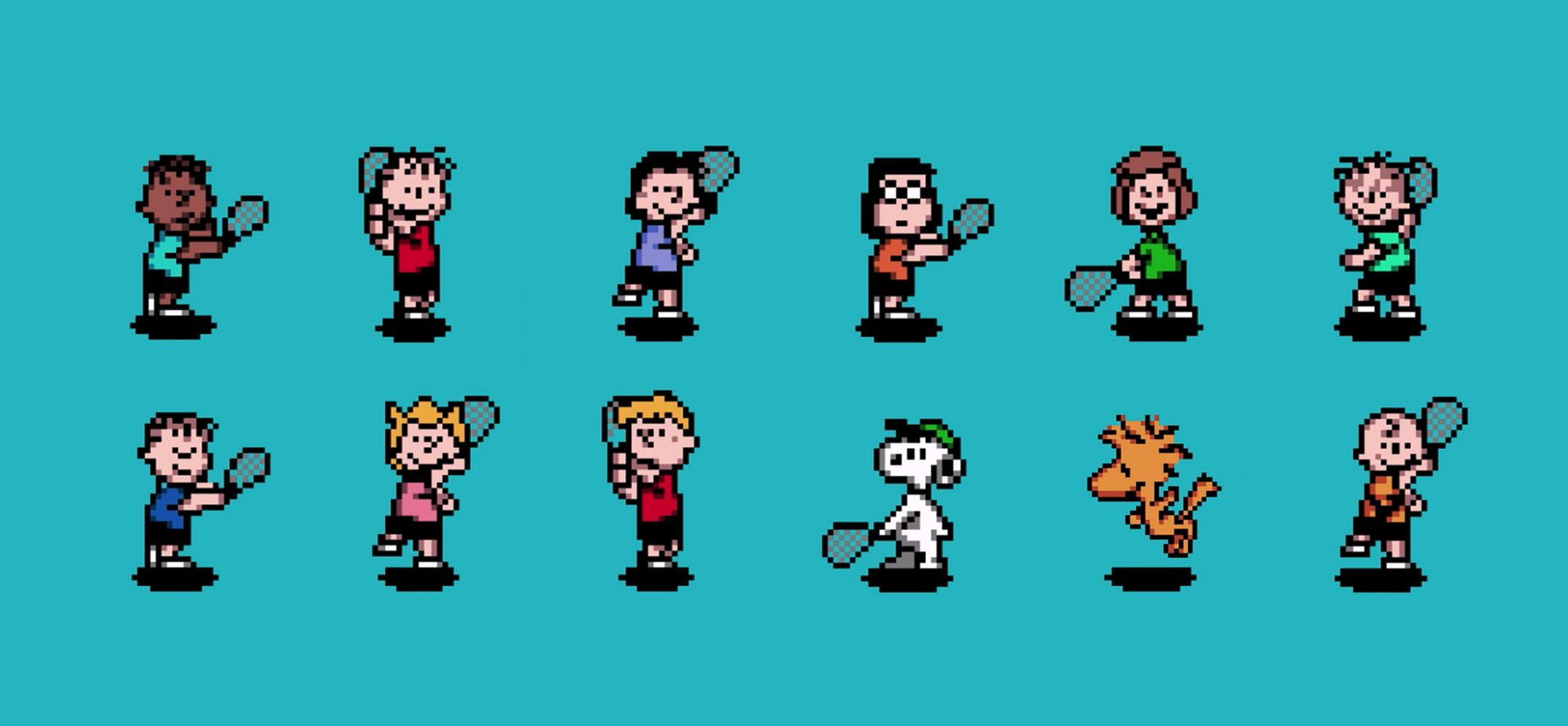
Though certainly less heralded than its plumber-led competitor, Mario Tennis, the famous beagle and his tennis adventures with the Peanuts gang in Snoopy Tennis will forever hold a place in Nintendo gaming lore. In Part 1, we traced the origins of the project up to the point where the game was ready for Nintendo to assess Brian and Martin's creation. Part 2 will follow the rest of the game's journey and the legacy it left on the gaming world. Second serve!!
Plumber’s Review
Each territory had its own master approval process, with Nintendo of America in Redmond, Washington being the gatekeeper in North America. For review purposes, a game sample had to be sent at around the halfway point of development, then again after the game was completed. Per the wording in a reference license agreement, NOA reserved the right, among other things, to check that “each Game Boy Color Game must appear significantly more colorful than monochrome Game Boy software,” and that the game was suitable, error-free, and properly certified and rated by the Entertainment Software Ratings Board in New York "E for Everyone."
BRIAN: All in all, development went pretty smoothly, and I don’t think it took too many attempts to get it approved. Nintendo grades various aspects of the game as part of the approval process, and we scored a massive 19.5 out of 20 for gameplay, so we were very happy with that feedback.
With final sign-off from the plumber, the cartridge manufacturing process began in the winter of 2000. In San Jose, Christopher Dawley compiled the North American version of the game manual to accompany a collection of material (including the game ROM) that was sent off to Nintendo for printing and assembly.
CHRISTOPHER: We had a lot of products that came over from other Infogrames studios around the world. They would re-publish them in the US since the development cost was already spent. We would get copies of the package, label, and manuals as assets that were already complete for other markets. Snoopy Tennis was one of those products that landed at Infogrames US fully formed. Most of our work was just swapping out the boilerplate information like copyrights, warnings, and localizing screenshots. We’d also alter the assets to meet Nintendo Of America’s standards. There was a lot of required stuff like legal lines and warnings that all of the first parties required be on the box and in the manual.

In addition to licensee and game integrity oversight for each region, Nintendo would perform cartridge manufacturing and packaging duties on behalf of the third-party publishers. The details about the real physical production of the cart are somewhat of a mystery, but Nintendo historian John Andersen sheds light on the likely process:
JOHN: Nintendo maintained strict control over quality since the Famicom cartridge days, when one publisher in Japan had permission to make their own Famicom cartridges and messed up and made a defective cartridge. Nintendo decided to control the manufacturing of all cartridges to maintain quality. At the time Snoopy Tennis was published for Game Boy Color, Nintendo had three factories, which are still owned and operated by the company to this day.
Crafting Magic from Silicon
The factories where the fabrication and assembly occurred were perhaps in the Uji, Uji-Ogura, or Uji-Okuba plants in Kyoto (the original home of Nintendo). You can confirm this on the back of a typical Game Boy Color box or game by finding a bit of small print indicating “Made In Japan”. And if you get the light to hit just right on any official (not bootlegged) Game Boy Color cartridge, there are dent stamps hidden on the front of the cartridge that may indicate which factory produced the cartridge. It’s unknown what this particular two-digit number means, but someone in Nintendo headquarters probably has a Rosetta stone for it.
Embedded onto the enclosed circuit board, memory chips would be sourced from a variety of places including Texas Instruments, Sharp, or, in the sample in the unit pictured, OKI Semiconductor in Tokyo according to software developer Joonas Javanainen (aka Gekkio). For budget reasons, the mermaid had to forgo the onboard battery (Mario Tennis has one) that can help hold game save data, opting instead for passwords to remember progress.
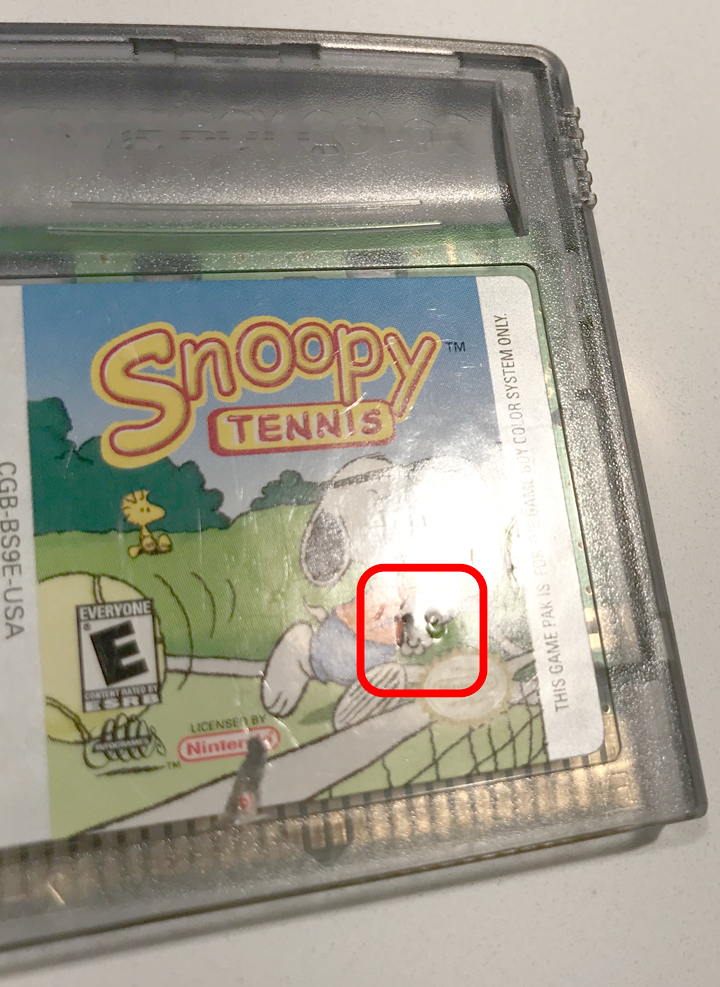
Sandwich a couple of billion transistors onto a green silicon wafer, weave them together with hair-thin copper conductive rivers, add a quartz crystal from Daishinku to keep the electrons in time, flash the game into permanent physical memory, add an iconic Game Boy Color transparent shell with the inner components visible for all to see, paste on the label and the cartridge is good to go.
Sliding into the back of a Game Boy Color console and powered on, electrons flow from the two AA batteries along the magic of semiconducting silicon doped with arsenic that can toggle the direction of energy through a vast nanoscopic array of logic gates into the main unit to initiate the display of the “Nintendo Game Boy Color” logo. Then energy travels through the left-most pin of the 36-pin connector, and flow of control switches to the cartridge read-only-memory, sending instructions back to the main unit to emblaze the screen with the Licensed By title card. Next comes the loopy unraveled Armadillo logo, then the Mermaid (in Japan the Hudson Soft logo would be next), then the language choice, and finally comes Snoopy in deep thought — back sprawled on a giant tennis ball — a colorized 8-bit version of the first panel of that Snoopy’s Tennis Book comic strip from decades ago.
After the Kyoto plants in Japan would do their own manufacturing quality checks and package the whole collection together into those signature square Game Boy Color boxes, they’d send big batches back to the states either directly to Infogrames warehouses or perhaps via the Washington State warehouse facility before making their way to the publisher’s operations hub.
DERBY TO WOODLAND HILLS: 5335 Miles
WOODLAND HILLS TO KYOTO: 5660 Miles
KYOTO TO DERBY: 9394 Miles
From notes in their annual reports, Infogrames inherited the domestic shipping and logistics setup from GT Interactive with warehousing from Arnold Logistics and Transportation provided out of Lancaster, Pennsylvania. Shipments from Japan likely ended up there in February 2001 at the latest, shuttling along the newly installed Dorner Sortation System, to be fanned out along conveyor belts and out to the freight trucks destined for the Walmarts and CompUSAs and Babbages of the country in time for the scheduled release.
In advance of the launch date, the marketing team kicked into high gear. Headed by Marketing Director Jeff Nuzzi and Marketing Manager Gregg Nolan, a solid campaign of audio-visual material was crafted and coordinated, including this bit of internet video memorabilia.
The press wave began as well. In February, the Peanuts licensing agreement and release date was finally formally announced to the public (making it seem like the entire game was developed in under 60 days). Then the month after Mario Tennis was featured in a massive 8-page spread in Nintendo Power, Snoopy Tennis snagged the hero position in the Game Boy section with a 2-page spread, edging out Disney, Nickelodeon, LEGO, and Warner Bros for the spot (which featured the likes of The Lion King, 102 Dalmatians, SpongeBob SquarePants, Lego Island 2 and Tiny Toons).
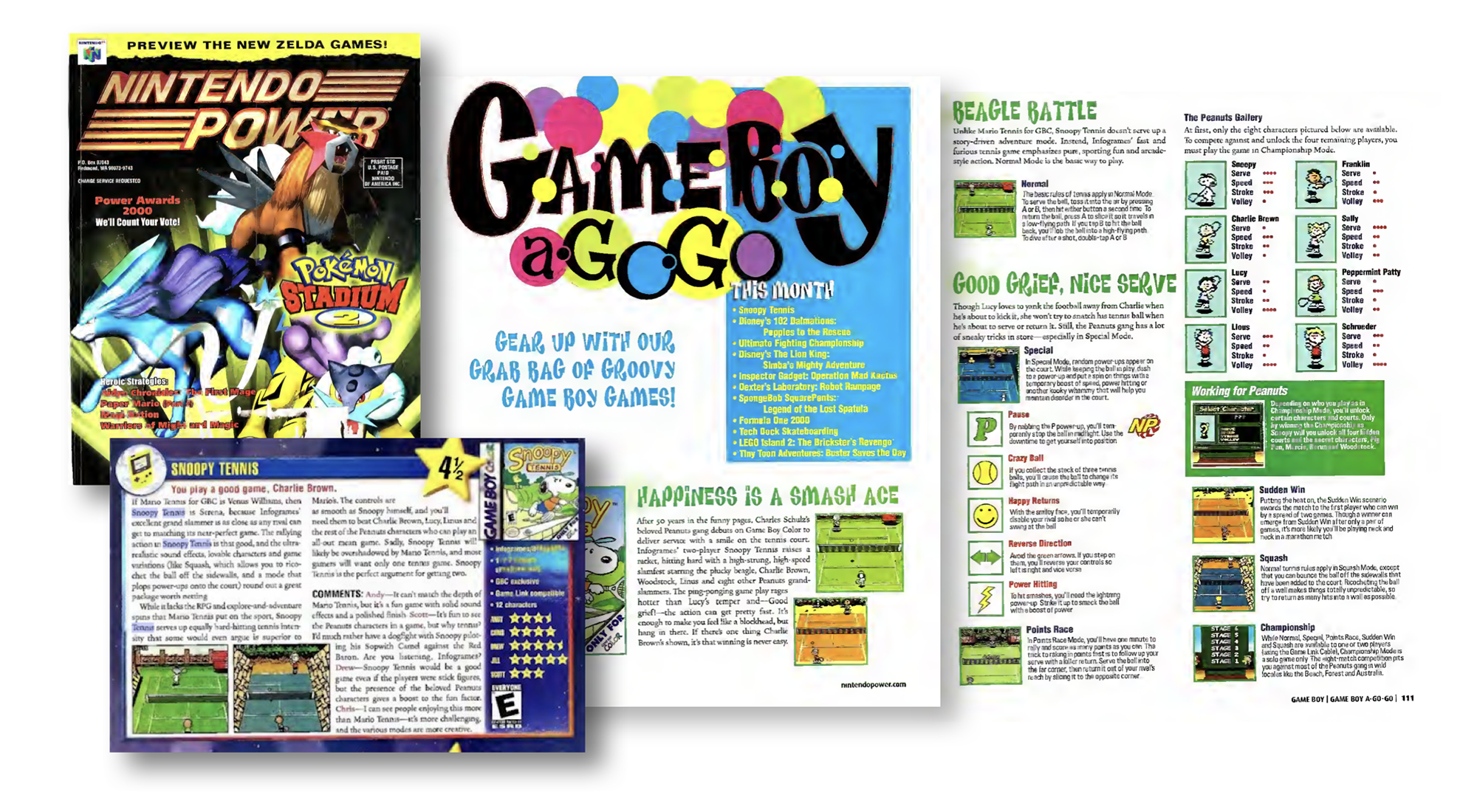
Critical Reception
BRIAN: Reviews were very positive. Most of them were in the 80–90% range and generally compared us very favorably to Mario Tennis. Nintendo Power had our favorite quote. “If Mario Tennis is Venus Williams, then Snoopy Tennis is Serena…as close as it gets to matching a near-perfect game.” We obviously really liked that quote, and it’s only gotten better with time, as Serena went on to eclipse Venus’ accomplishments.
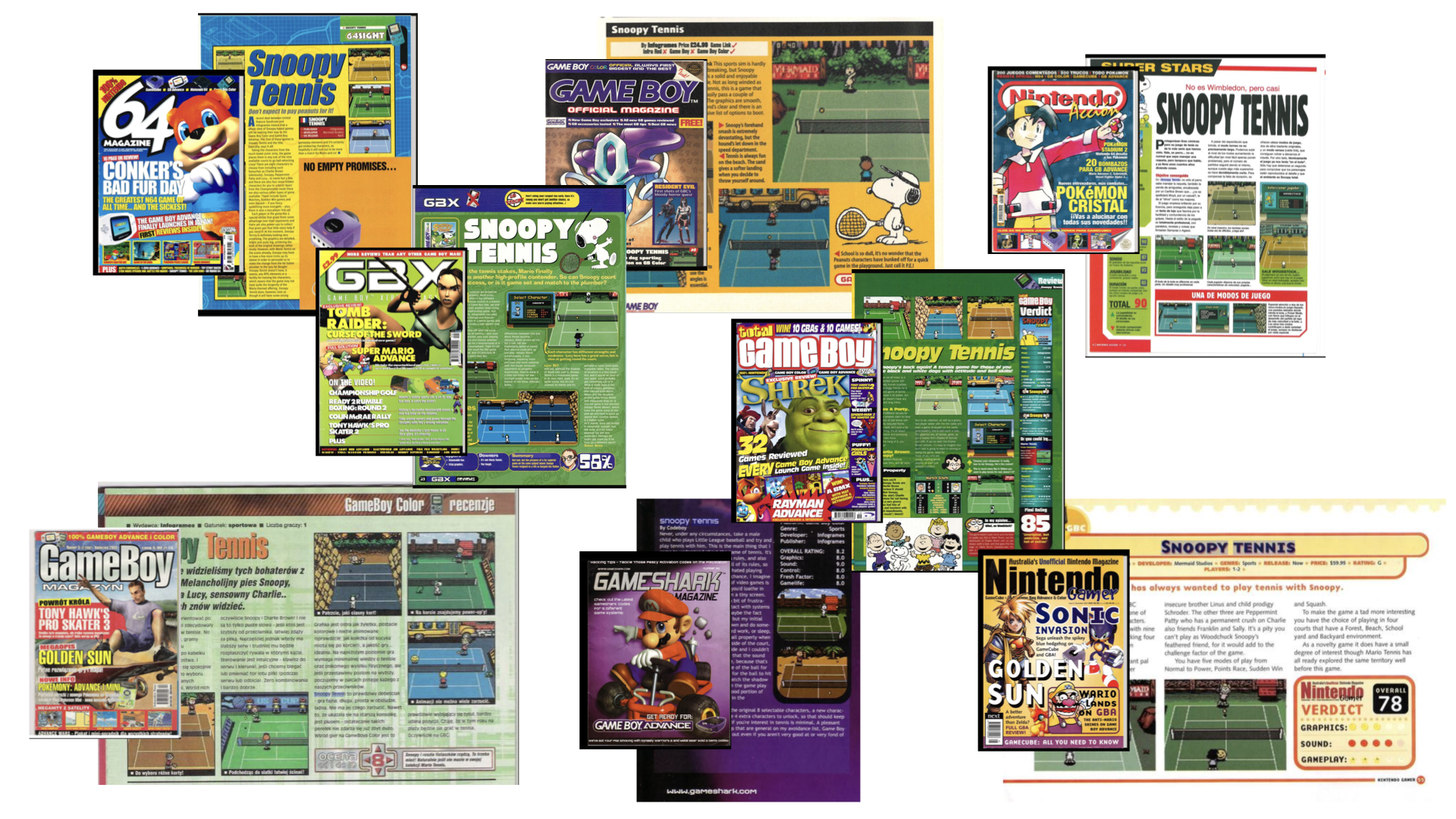
GAME REVIEW RATINGS FOR SNOOPY TENNIS:
NINTENDO POWER 4.5/5 | GAMESHARK 8.2/10 | TOTAL GAME BOY 85/100 GAME BOY OFFICIAL 88/100 | GAME BOY MAGAZYN 8/10 | GBX 58/100 NINTENDO ACCIÓN 90/100 | ALLGAME 4.5/5 | GAMEPRO 4/5
NINTENDO GAMER 78/100 | GAME INFORMER 7/10
An ad page ran in a variety of publications, as well as internet banners, the trailer, and marketing material across the interwebs to be in the market in April when the game was in stores. Among the tie-ins, the perennial Welch’s license (maker of those collectible Peanuts cups) was tapped for a sweepstakes on the Welch’s site called the “Center Court Challenge” to win a copy of the game.
As the project progressed, the game’s material and marketing were localized and customized for the upcoming international releases. The team from the joint partnership with Hudson Soft in Tokyo (the Japanese manual does not include a credits page like the UK and US versions) lined up a slot in the third-anniversary issue of McJoy, the in-store monthly promotional magazine from McDonald's in Japan. Flipping past the Hawaii “Oahu Ohana” summer travel section, the movie review of “Save The Last Dance”, the ads for Snoopy branded credit cards and Snoopy branded Swarovski watches, the beagle was included in the “Presents” page where McDonald’s credit card members (yes, McDonald's has a branded credit card) could send a postcard in for a chance to win a copy of the game.

In the UK, the armadillo tasked the “Landmark House” team headed by Brandon Smith to produce the adaptation for the European markets.
BRANDON: That is probably me in the credits, but unfortunately I didn’t actually work on Snoopy Tennis…at least I don’t think I did. What often happens in the games industry is the manual from one game is used as the template and copied over to the next and not always thoroughly updated on the publisher side, especially for smaller titles. There IS another Brandon Smith in the business and he is a developer. We’ve never worked together, but it’s certainly possible he was with the developer on Snoopy and that is actually him!
Mario Tennis hit the market first, landing in Japan in November 2000, and then Europe and the US markets in January and February 2001. Snoopy Tennis would drop in April in North America, then over the summer in Japan and in the fall of 2001 in Europe.
With the phased roll-out dates between territories, Brian and Martin took the time to continue to refine the game, coding features into the European and Japanese releases that are missing from the North American version.
BRIAN: We added a few minor AI tweaks, as well as short celebrations and racket-smashing animations after each point.
Against the 40+ person development team that worked on Mario Tennis, this whole achievement is stark. For a lone programmer and designer hustling for the majority of development on nights and weekends only, the game is all the more surprising in its depth. Snoopy Tennis includes a dozen characters each with unique play styles, a challenging competitive AI, multiple court environments, and multiple game modes including “squash mode” where you can play the ball off the side walls. Martin and Brian even managed to build in local two-player functionality via the Game Link.
MARTIN: The networking did complicate the code a bit. I had to test using real machines, which was a pain. It used a method called “lockstep”. You basically have to make sure that everything on the two machines is completely the same when you initiate the connection so all memory and variables have to be cleared out. When that finally worked I was quite happy.
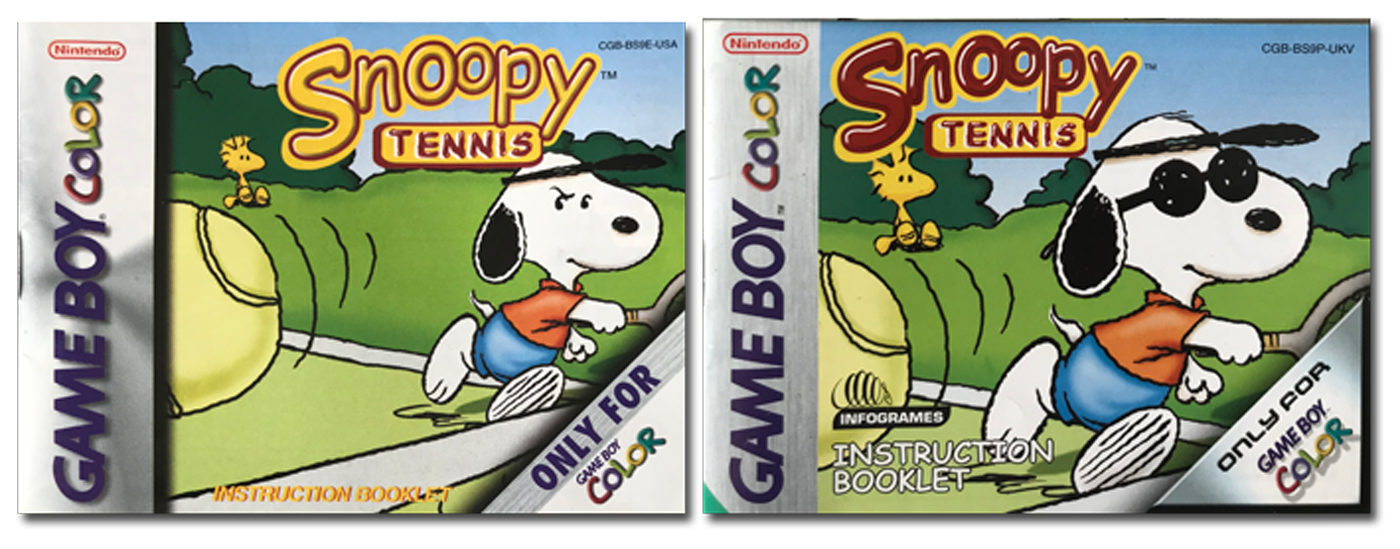
[Side-note: One of the remaining mysteries of the game is why Snoopy donned the sunglasses for the cover of the European release. Did the Brits expect a kinder more gentle tennis Joe Cool version of beagle than Americans? Are they more protective of eyesight than other countries? Maybe someday we’ll know for sure.]
MARTIN: Normally when you work for a game company you receive one copy of the game you worked on if you’re lucky, but for Snoopy Tennis, and since we were “a company” we received over 50 copies which was a crazy experience as we were only 2 people.
BRIAN: We were almost more excited about getting our hands on those than getting the final milestone payment. And although we had seen physical copies of other games we had worked on before, it was definitely a super exciting moment, when we got the box with all the international versions and gazed upon our creation. But if Martin tells you I would spread my copies out on my bed and roll around in them, that’s a total lie. IT NEVER HAPPENED!!!
In the Infogrames annual earnings report, the costs and revenues for all published titles are aggregated so it’s tough to tell how many individual units were made and how financially successful Snoopy Tennis itself was, but the armadillo did provide a breakdown by category:
FORM 10-K: During fiscal 2001 (June 30, 2000 — June 30, 2001), the Company’s product mix consisted of 65% PC games, 23% Sony PlayStation games, 6% Sony PlayStation 2 games, 3% SEGA Dreamcast games, and 3% Nintendo Game Boy games. Approximately 65% of revenues were related to PC product revenues and 35% of revenues were related to console games.
Performing some very bad math, net revenue was reported at $310.5 million which would leave $108.7 million (35%) for the console market, of which $3.27 million (3%) might have been from total game sales for the Nintendo product category.
There were 10 Game Boy Color titles released by the Infogrames divisions that fiscal year in North America. Dividing by ten leaves approximately $325,000 thousand as a potential benchmark for Snoopy Tennis net revenue. At a retail price of $29.99, and even assuming a wholesale and retail markup, total units sold would be nowhere near the 1.1 Million copies that Mario Tennis achieved. David Fremed, the armadillo CFO at the time has not responded to inquiries to confirm.
INFOGRAMES GAME BOY COLOR RELEASES: JULY 2000 — JULY 2001
Test Drive Cycles, Rocky Mountain Trophy Hunter, Q*Bert, Galaga Destination Earth, Frogger 2 Swampy’s Revenge, Looney Tunes Marvin Strikes Back!, Test Drive 2001, Looney Tunes Racing, Snoopy Tennis, Power Strike Pro Beach Volleyball
With two tennis games on the market at the same time, but one backed by the Nintendo first-party publishing juggernaut it was inevitable that the other would be overshadowed. Had Snoopy Tennis made it to market first in time for that holiday rush in 2000, the story might have been different — the plumber would have been compared to the beagle rather than the other way around.
MARTIN: For me, it was always a strange feeling when the game you have just worked on for ages hits the shelves — completely euphoric but at the same time so final and empty.
Snoopy Tennis would be the one and only published game capitalizing on the five-year license Infogrames had for the Peanuts brand (Namco snagged the license when it came up for renewal in 2005).

Mermaid’s End
Once the game was completed, Brian and Martin briefly looked to make a go of it as an independent game company with Infogrames as a client.
BRIAN: Infogrames were trying to get us onto another project for them. They were taking bids from developers for a Mission: Impossible and Superman games. We actually put together a rough, but kind of cool-looking playable Gameboy Advance demo of a Superman game, but neither project ended up going ahead. I was a little disappointed we didn’t get to do the GBA version, as I’m a huge Superman fan.
After three years together at Mermaid Studios, Martin and Brian parted ways — with Jensen moving to California briefly to join Shiny Entertainment in 2002 (soon to be another inescapable Infogrames company acquisition). The undying love for tennis did lead Brian to get Martin to team back up again under the Mermaid Studios shingle to create Power Play Tennis (aka Tennis Masters) for the Nintendo DS, released in Europe in 2007 by CodeMasters and System 3 Software. You can see their names “Martin|Brian” in the screenshots of the game scoreboard.
From the “I-Stars” team, Christophe is now co-founder of “50 Productions” for AR/VR games and projects out of Los Angeles. Erick is the owner of “ApexWins” creating visual content for social media out of Italy. Jeff is a co-founder of “Like Pizza Studios” creating video games and animation in Pasadena, California. Gregg is now a stunt double and skydiver for the film industry.
As for Martin, he’s back in Denmark fielding contract work for game development and is consulting for a new app that mixes gaming and dating.
MARTIN: I had so much fun working on Snoopy Tennis and to this day I still consider it one of my best games.
Brian continues to create art and design for game developers as well as contract work for the creation and editing of promotional web and video content.
BRIAN: Revisiting Snoopy Tennis has made me wonder if maybe it’s time to do another tennis game. Nintendo Switch seems kinda fun.
Now, in celebration of the 70th anniversary year of Peanuts, the 40th anniversary of the original Snoopy Tennis Game & Watch, and the 20th anniversary of Snoopy Tennis for Game Boy Color, it might be time to get out there and claim the Snoopy Tennis trophy on hard mode in a single play-through as Snoopy himself.
Good luck, Chuck.
Special thanks to these folks for their contributions to this story: Martin Jensen, Brian Lau Tomcsyk, Erick Fernandez, Gregg Nolan, Brandon Smith, Brian Turner, Christopher Dawley, Michael Haller, Ronald Rudolph, Laddie Ervin, Joonas Javanainen, Stephen J. Lynd, Craig Harris, John Anderson, Dave Taylor, Jake Simpson, Sarah Breaux, and Alex Pham. Also, a moment of appreciation for the Internet Archives and the Wayback Machine, without which many of these gems of nostalgia would have been lost to the internet plumbing ruptures.
Correspondences were traded via email and LinkedIn messaging in late 2020 and early 2021 and have been edited for grammar, capitalization, and punctuation. Additional information beyond what is hyperlinked was sourced primarily from old Infogrames quarterly and annual reports.
